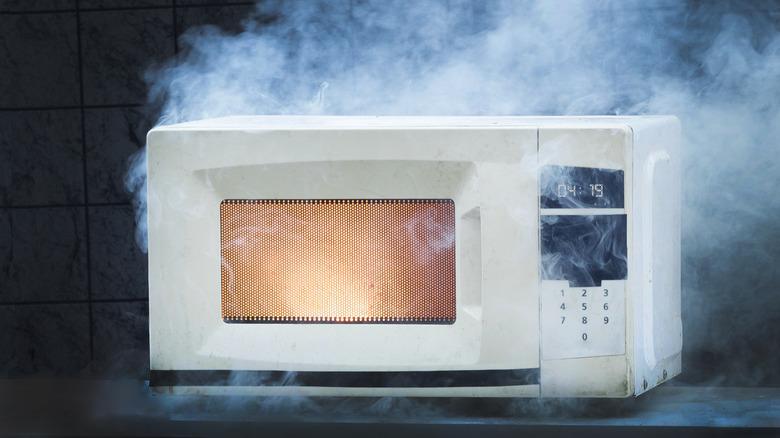The Explosive Danger Of Microwaving Grapes
Grapes may be tasty, bite-sized fruits that are fun to nibble and nosh, but they also have a dangerous secret: Microwaving them can create a miniature fireworks show and an explosion of plasma.
When you cut a grape almost in half — leaving a bit of the skin that connects the two severed sides — and then heat it up in the microwave, you'll witness this mess, which is basically a fusion reaction that leads to the formation of plasma.
We're not talking about the plasma flowing through human bloodstreams. The plasma in this situation is the fourth state of matter: ionized gas. Like liquid evaporating into a gaseous state when it's boiled, gas turns into plasma when it's heated up.
If you want an idea of how hot plasma is, consider this: Our sun, nebulae, and lightning are all in plasma states. That kind of heat can do a lot of harm well beyond overcooking a grape. It can also lead to destroyed microwaves, fires, and even property damage in extreme cases. So, maybe don't attempt to recreate this pint-size apocalypse at home.
The science behind the fruit-based blowup
Dr. Derek Muller, physicist and creator of the science-based YouTube channel "Veritasium," uploaded a fascinating video to the platform in 2011 where he and fellow physicist Dr. Steve Bosi demonstrated the fruit-to-fireball phenomenon.
Unfortunately, the explanation Muller gives in this clip of why grapes go "boom" in the microwave isn't very detailed — at the time, no one actually knew why the phenomenon happened. But, that changed in 2019 when a few curious scientists from the University of Illinois at Urbana–Champaign started conducting experiments in order to reveal the truth behind why microwaving a grape creates plasma. They published their findings in a study in the journal Proceedings of the National Academy of Sciences. As they stated, "The formation of plasma is due to electromagnetic hotspots arising from the cooperative interaction of Mie resonances in the individual spheres."
To translate, when the nearly-split grape is cooked in a microwave, each piece's electromagnetic field starts interacting with the other. This interaction creates a ton of electromagnetic energy where the grape's skin that connects the two halves and the molecules in the area start moving super fast, creating a hot spot that sparks and leads to plasma.
The effect of microwaves on grapes
So why does this effect only happen in the microwave? And why does it happen to different types of grapes? Dr. Derek Muller made a follow-up video in 2019 that answers both questions. As he explains, microwaves generate heat through radiation. Inside the appliance, microwave wavelengths that circulate in the air around the grape measure about 12 centimeters. However, the wavelengths inside the grape are much smaller — roughly 1.2 centimeters, which is just about the width of the fruit.
The size discrepancies and the fact that light can travel fast in a grape can cause microwave rays to become trapped inside the fruit. Microwaving a grape causes heat to generate from the inside out, not the outside in, which is the opposite of what happens when you warm up a Hot Pocket in the machine, for example: It warms up the outside first and then works its way in (which is why, sometimes, the inner part of the food can still be cold if not given enough time).
When you cut a grape almost fully open, however, the rays have freedom to move, and the electromagnetic fields create enough heat to ionize the air. These newly formed ions can take on more energy (i.e. get hotter), which leads to sparks and smokin' hot plasma. So, maybe next time, just enjoy frozen grapes instead — they're much safer and have some fun uses like keeping wine chilled.



